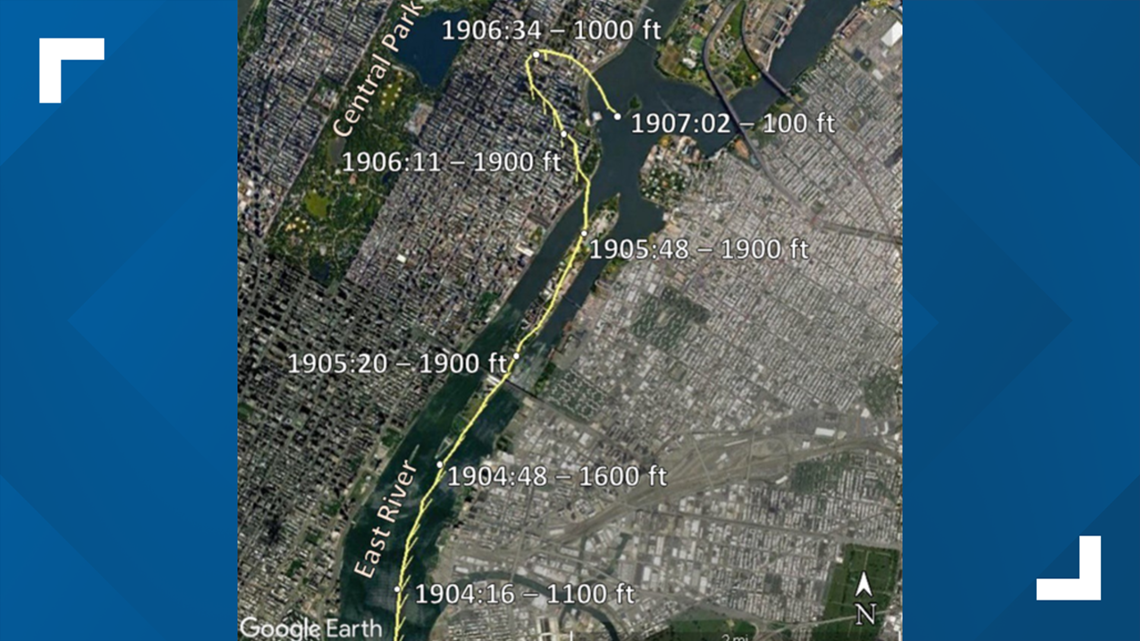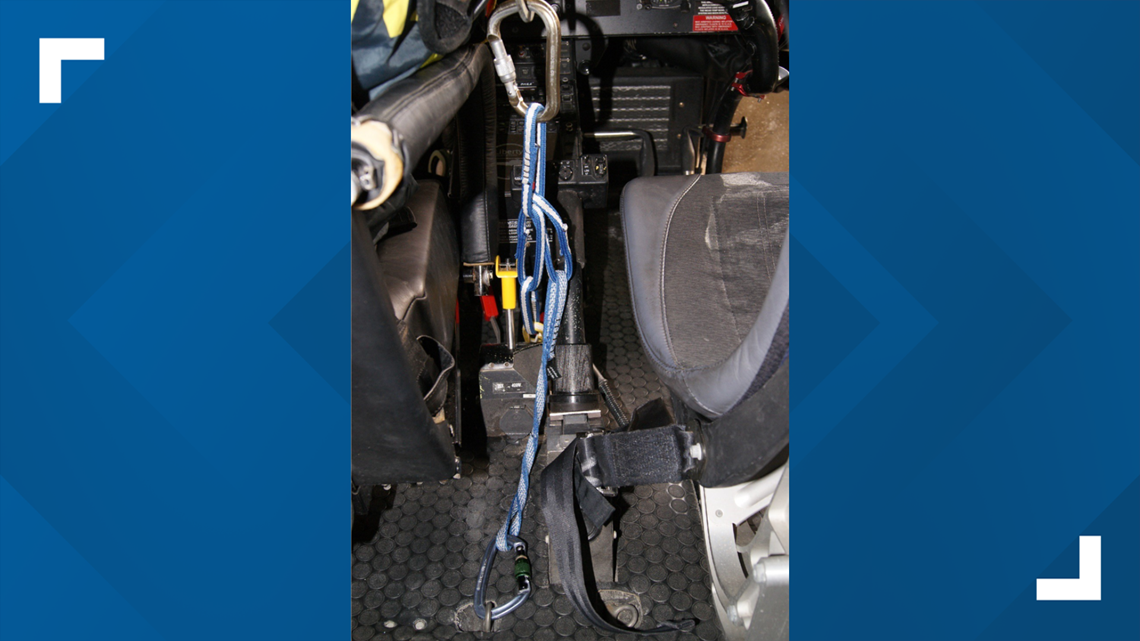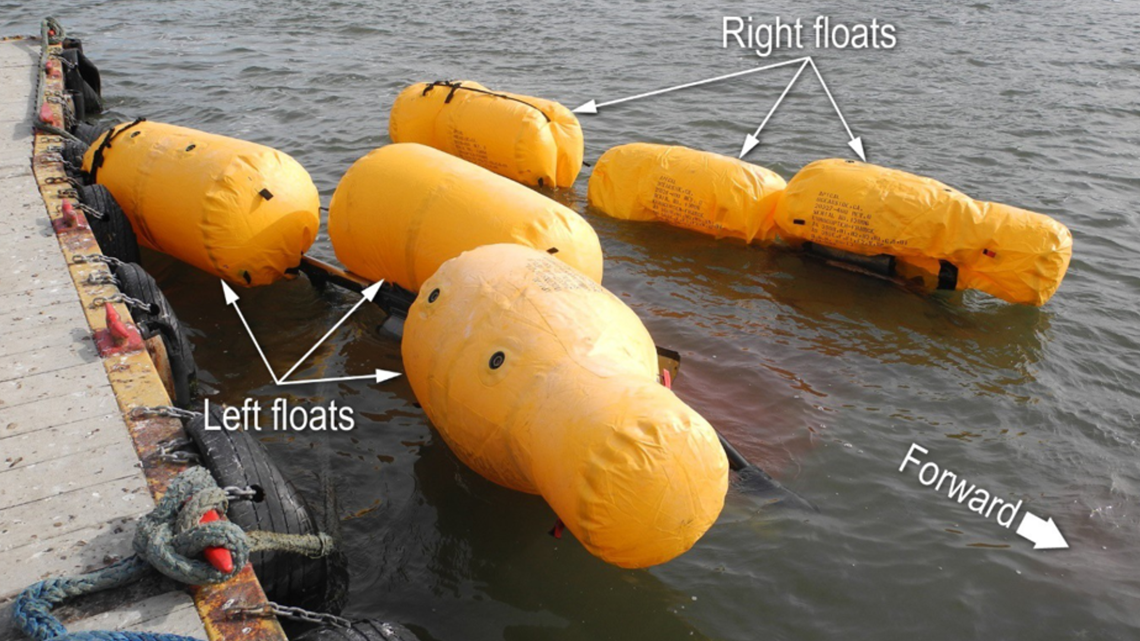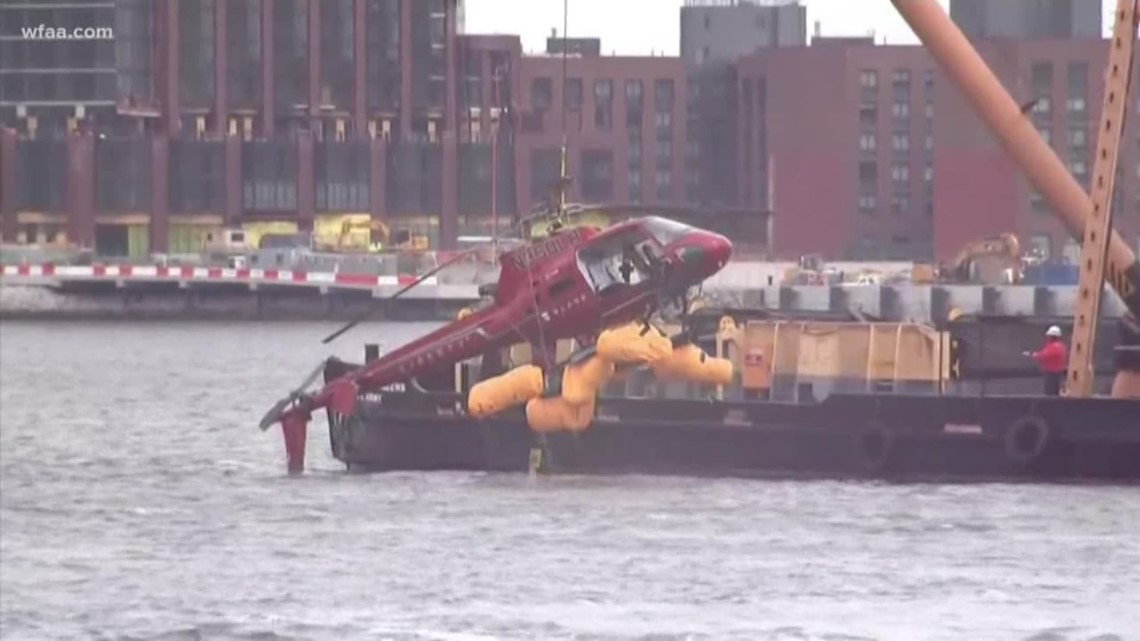NEW YORK — The National Transportation Safety Board on Friday blamed a secondary passenger restraint system for causing a 2018 helicopter crash in New York City that killed two Dallas men and three other passengers.
In the final report, the NTSB found probable cause that a restraint worn by the front-seat passenger pulled an emergency fuel shut-off lever into “shutoff” position causing the engine to lose power. The pilot was forced to land the helicopter in the East River, where it rolled and was submerged.
All five passengers drowned after they became trapped in their harnesses. Among the passengers killed was former WFAA intern Trevor Cadigan, 26, who’s the son of WFAA production manager Jerry Cadigan.
Dallas firefighter Brian McDaniel, 26, also died.


The three other passengers killed in the crash were Carla Vallejos Blanco, 29; Daniel Thompson, 34; and Tristan Hill, 29.
Among its 20 findings, the NTSB said the helicopter’s landing in the river was “survivable,” but the secondary restraint system didn’t allow passengers to “quickly escape” as the helicopter went underwater on March 11, 2018.
THE SIGHT-SEEING TOUR
The five passengers boarded the NYONair-owned helicopter being operated by Liberty Helicopters Inc. for a 30-minute aerial sight-seeing tour around New York City scheduled to take off at 7 p.m. For the tour, Liberty had the two right and the front left doors of the helicopter removed. A sliding door on the left side of the helicopter was locked open, the NTSB found.


The doors-off tour was meant to give passengers an opportunity to take unobstructed photos of attractions while flying. Passengers also had the chance to dangle their legs out of the helicopter during portions of the flight.
One passenger was seated in the front seat. Four passengers were seated in the back of the helicopter.
According to the NTSB’s report, all five passengers were wearing two sets of restraints. The first set was an FAA-approved safety harness. The second set was a NYONair harness system that tethered passengers to the helicopter using carabiners and straps to prevent them from falling out during the doors-off flight. The NYONair system came with a pouch that carried a sharp blade to cut through the straps in case of emergency.
The 33-year-old pilot only wore the FAA-approved restraints, the report noted. He survived.
In a preliminary report released weeks after the crash, the NTSB noted the pilot told investigators that at about 6:45 p.m., he "checked his passengers' harnesses and put their life vests on. He pointed out where the cutting tool was located on their harness and explained how to use it. He then seated the passengers and secured their harness tethers to hard points on the helicopter. After the passengers were seated, loading personnel assisted them with putting on the helicopter's restraints."
RELATED: NTSB releases video transcript of deadly 2018 NYC helicopter crash that killed 2 from Dallas
LOSS OF ENGINE POWER
Shortly before 7 p.m., the helicopter took off from a New Jersey heliport for its tour of Manhattan.
During its investigation, the NTSB reviewed video from inside the helicopter, as well as video recorded by a backseat passenger’s iPhone X.
Video recovered from a camera mounted to the ceiling of the helicopter showed two backseat passengers were allowed by the pilot to remove their FAA-approved restraints and sat down on the floor of the cabin, according to the NTSB’s report.
Investigators determined that the front seat passenger’s harness that tethered him to the helicopter dangled near floor-mounted helicopter controls when the passenger leaned back to take photos, the report said.
“At one point, when he pulled himself up to adjust his seating position, the tail of his tether remained taut but appeared to pop upward. Two seconds later, the helicopter’s engine sounds decreased, and the helicopter began to descend,” the report said.


As the pilot performed emergency procedures, he noticed the helicopter’s fuel shutoff lever was in the “shutoff” position, the report said. The pilot saw that the tail of the front passenger’s tether had caught onto the lever and pulled it into the “shutoff” position.
The pilot restored fuel flow and tried to restart the helicopter, the report said, but “the helicopter was too low to allow engine power to be restored in time to prevent the emergency landing.”
The report noted the pilot initially considered landing in Central Park, but “there were too many people.” The pilot turned toward the East River.
TRAPPED BY THE HARNESSES
According to the report, five seconds before the helicopter landed in the East River, the pilot was heard on video telling passengers, “Prepare yourself for exiting the helicopter.”
Immediately after hitting the water, a passenger in the back of the helicopter asked, “How do I cut this?” referring to the straps on the safety harness, the report said.
NTSB investigators noted that video showed several passengers attempting to remove the secondary harness-tether restraints as water began to fill the helicopter’s cabin.
One passenger from the backseat was seen on video attempting to move toward an open door of the helicopter, the report said. But, the cord for his headset was secured to the back of his harness and “became taut.”
It took only eleven seconds from the time the helicopter landed on the water for it to roll over, invert, and become submerged.
The pilot was able to successfully remove his FAA-approved restraint. Rescuers pulled him from the water where he was found clinging to the upside-down helicopter, the report said.
EMERGENCY FLOATS
During its investigation into the crash, the NTSB also looked into emergency floats that are designed to keep a helicopter upright on water, if deployed.
Photos from the crash scene included in the report show some of the floats only partially deployed. The NTSB found that when the pilot pulled the lever to inflate the flotation system, he did not pull hard enough to fully deploy both sides of the flotation system.


The NTSB recreated the scenario with the flotation system as part of its investigation and found “a force of about 45 lbs on the activation handle was required before the left reservoir assembly activated. Subsequent tests found that a force exceeding 58 lbs was needed to pull the activation handle fully aft to activate the right reservoir assembly.”
The NTSB’s report issued five findings related to the emergency flotation system.
FINDINGS AND RECOMMENDATIONS
Overall, the final report included a list of 20 findings and 16 recommendations.
Among the specific findings outside of the cause of the crash, the NTSB cited “Liberty Helicopter Inc.’s and NYONair’s decision to use locking carabiners and ineffective cutting tools as the primary means for passengers to rapidly release from the harness/tether system was inappropriate and unsafe.”
The NTSB is calling on all commercial air tour operators to implement a safety management system to better protect passengers and pilots.
Additionally, the NTSB recommends the FAA require special approval for companies seeking to install and use secondary restraint systems. Until that approval process is in place, the NTSB is asking the FAA to “prohibit the use of” supplemental restraint systems for passenger-carrying doors-off flights.
The NTSB points out "None of the following were factors in this accident: (1) the pilot's qualifications, which were in accordance with federal regulations and company requirements; (2) pilot fatigue or medical conditions; and (3) airworthiness of the helicopter."
The pilot held commercial and flight instructor certificates for both "rotorcraft-helicopter and instrument helicopter," the report said. He also held an advanced ground instructor certificate.
The NTSB's final report mentions the pilot had 3,100 hours of flight experience total. He logged 1,430 hours as pilot of the Airbus AS350, the helicopter model flown on March 11, 2018.
FAMILY'S LAWSUIT
Since the crash, the family of Trevor Cadigan, who grew up in Dallas and graduated from SMU, filed a lawsuit against Liberty Helicopters, the pilot, and the tour operator NY on Air. The lawsuit claims they are "negligent in that their policy of so-called helicopter 'doors off' photo flights is inordinately dangerous and risky and should only be permitted for professional photographers in special situations and not for amateur tourist photographers."
The lawsuit also targets the company policy of "providing a knife to each passengers to cut through their harness to extricate themselves is grossly negligent and reckless," and states that the restraint system used, "securing passengers to the helicopter with harnesses attached from the back by a metal ring known as a carabiner which is a death trap and does not permit them to reach and activate release mechanism on their own."
You can read the NTSB’s full, 146-page final crash investigation report here.

